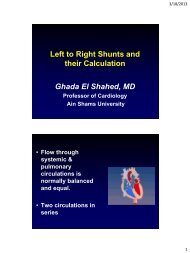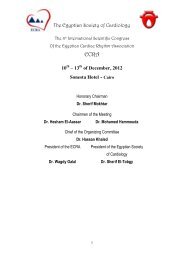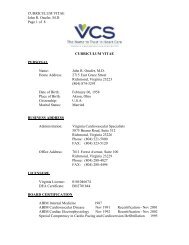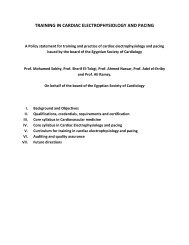the egyptian society of cardiology board of ... - Cardioegypt.com
the egyptian society of cardiology board of ... - Cardioegypt.com
the egyptian society of cardiology board of ... - Cardioegypt.com
Create successful ePaper yourself
Turn your PDF publications into a flip-book with our unique Google optimized e-Paper software.
Endo<strong>the</strong>lial Dysfunction & Insulin Resistance in Normoglycemic Offsprings<br />
particularly in skeletal muscle [10]. Insulin stimulates<br />
bulk flow as an endo<strong>the</strong>lium-dependent vasodilator<br />
via nitric oxide production [11]. Impaired<br />
endo<strong>the</strong>lial function in type 2 diabetics is documented<br />
by reduced effect <strong>of</strong> endo<strong>the</strong>lial-dependent<br />
vasodilators such as acetylcholine (ACH) [12].<br />
Insulin resistance is defined as a state <strong>of</strong> reduced<br />
responsiveness to normal circulating levels <strong>of</strong><br />
insulin. This condition is a feature <strong>of</strong> various<br />
disorders, such as type 2 diabetes, is also implicated<br />
in impaired glucose tolerance (IGT) or impaired<br />
fasting glucose (IFG), both considered as ''prediabetes''<br />
by <strong>the</strong> Expert Committee on <strong>the</strong> Diagnosis<br />
and Classification <strong>of</strong> Diabetes Mellitus, as well as<br />
in obesity, hypertension, dyslipidaemia [13], <strong>the</strong><br />
possibility <strong>of</strong> existence <strong>of</strong> earlier in life metabolic<br />
effect in genetically predisposed persons as <strong>of</strong>fspring<br />
<strong>of</strong> type 2 diabetics was thought as ano<strong>the</strong>r<br />
face <strong>of</strong> <strong>the</strong> coin.<br />
Whe<strong>the</strong>r family history for diabetes predispose<br />
to alteration in vascular function through an unknown<br />
''genetic susceptibility'' or through higher<br />
prevalence <strong>of</strong> insulin resistance has not yet been<br />
fully investigated. The aim <strong>of</strong> <strong>the</strong> present study<br />
was to investigate endo<strong>the</strong>lial function in normotensive<br />
normoglycemic <strong>of</strong>fspring <strong>of</strong> diabetic subjects<br />
and to explore its relationship with <strong>the</strong> insulin<br />
resistance.<br />
Patients and Methods<br />
The study population consisted <strong>of</strong> 57 subjects:<br />
NOPD group: 36 healthy subjects, with one or<br />
both parents having type 2 diabetes mellitus.<br />
Control group: 21 healthy normotensive normoglycemic<br />
subjects with no family history <strong>of</strong><br />
type 2 diabetes mellitus.<br />
Exclusion criteria: Tobacco smoking, history<br />
or clinical evidence <strong>of</strong> cardiac diseases or systemic<br />
diseases, obesity [body mass index (BMI) ≥30kg/<br />
m 2 and/or Waist-to-hip ratio (WHR) >0.9m in<br />
males and >0.85m in females], hypertension, diabetes,<br />
or dyslipidemia. All women were premenopausal<br />
and <strong>the</strong>ir investigations were undertaken<br />
during <strong>the</strong> first week <strong>of</strong> <strong>the</strong>ir menstrual cycles.<br />
None <strong>of</strong> <strong>the</strong>m were taking oral contraceptives.<br />
Anthropometric, metabolic characteristics and<br />
laboratory measurements:<br />
Height, weight and waist circumference were<br />
determined for all participants. BMI was determined<br />
as body weight (kg)/height (m) 2. Total and<br />
20<br />
HDL cholesterol, triglycerides and routine chemistry<br />
were measured by standard laboratory techniques.<br />
Oral glucose tolerance test (OGTT):<br />
A standard OGTT was done after an overnight<br />
10- to 12-h fast. Blood samples were obtained<br />
before and 2h after 75g <strong>of</strong> glucose administration.<br />
Homeostasis model assessment (HOMA):<br />
Serum insulin was determined by an electrochemiluminescense<br />
assay. Insulin resistance [14]<br />
was calculated as follows:<br />
HOMA-IR=fasting glucose (mmol/L) x insulin (mIu/mL)<br />
––––––––––––––––––––––––––––––––––––––––––––––––<br />
22.5<br />
Endo<strong>the</strong>lial function:<br />
Endo<strong>the</strong>lial function was measured 1h before<br />
<strong>the</strong> OGTT was started. All studies were performed<br />
in <strong>the</strong> morning in a quiet room. Brachial artery<br />
reactivity was measured by colored Doppler ultrasound,<br />
using a 7.5MHz linear array transducer<br />
ultrasound system. The mean right brachial artery<br />
antero-posterior diameter was measured 3-5cm<br />
above <strong>the</strong> elbow, between media and adventitia<br />
from 4 cycles synchronized with <strong>the</strong> end-diastole<br />
at <strong>the</strong> R wave peaks [15]. The ECG was monitored<br />
continuously throughout <strong>the</strong> study.<br />
• A basic scan <strong>of</strong> <strong>the</strong> brachial artery diameter and<br />
flow was taken.<br />
• 2 nd scan was taken after applying a pneumatic<br />
tourniquet <strong>of</strong> 250-300mmHg. (Using mercurial<br />
sphygmomanometer) for about 5 minutes. The<br />
scan was taken to measure brachial artery diameter,<br />
60 seconds after releasing <strong>the</strong> tourniquet<br />
measuring <strong>the</strong> maximum FMD (index <strong>of</strong> endo<strong>the</strong>lium-dependent<br />
vasodilation).<br />
• 3 rd scan was taken after 15 minutes <strong>of</strong> rest to<br />
allow recovery <strong>of</strong> <strong>the</strong> artery after FMD and considered<br />
<strong>the</strong> basic scan <strong>of</strong> GTN-MD reading.<br />
• 4 th scan was taken 4 minutes after administration<br />
<strong>of</strong> 400mg <strong>of</strong> GTN spray sublingually to assess<br />
non-endo<strong>the</strong>lium dependent dilation. GTN serves<br />
as an exogenous source <strong>of</strong> Nitric Oxide (NO),<br />
bypassing <strong>the</strong> need for endogenous endo<strong>the</strong>lial<br />
NO production.<br />
o FMD percentage was calculated by <strong>the</strong> following<br />
equation:<br />
2 nd scan – 1 st scan<br />
FMD% = ––––––––––––––––– x 100<br />
1 st scan








